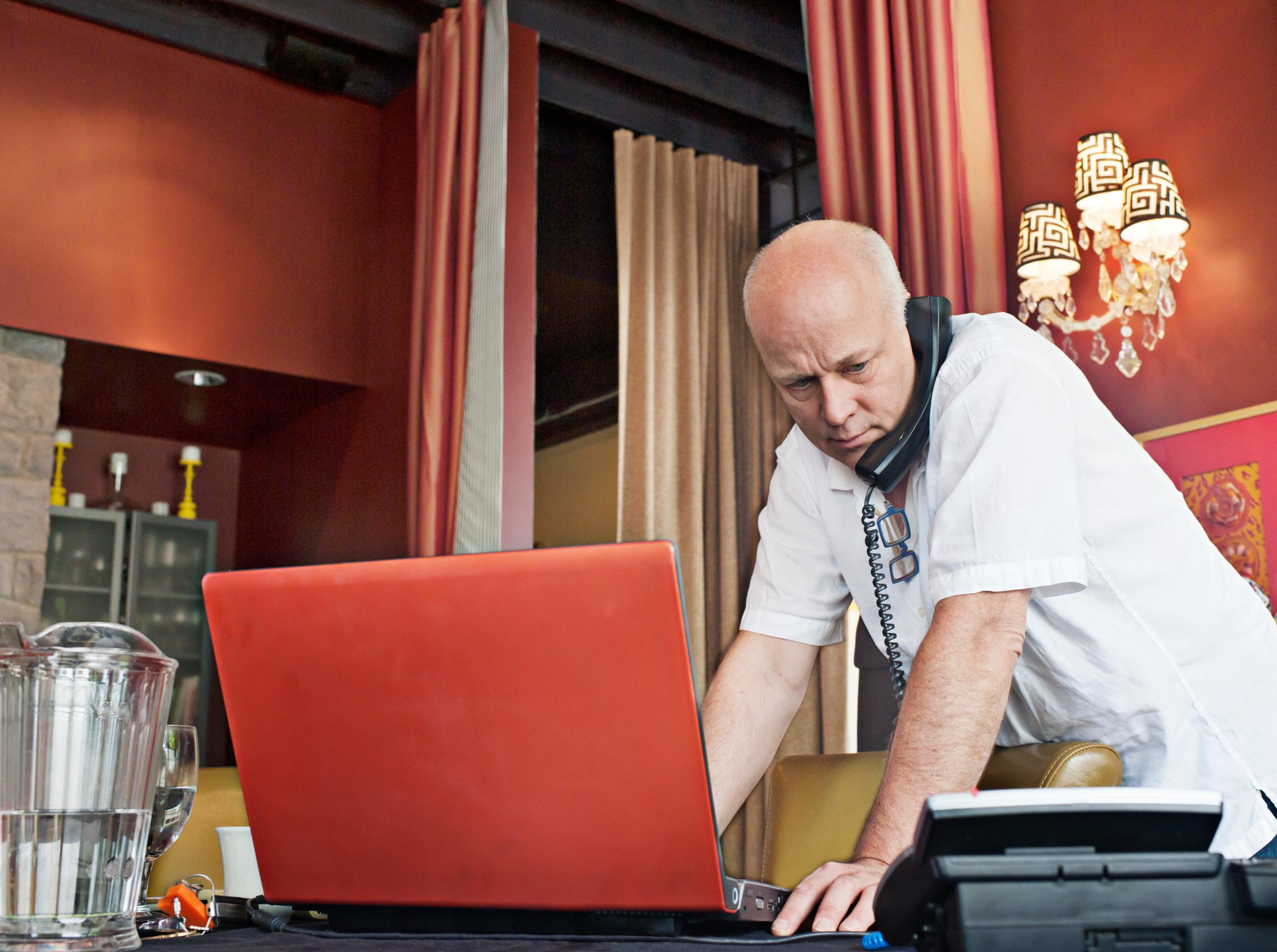

It’s 2:00 p.m. Your lunch sits snugly in your stomach causing fog to settle over your brain. Your energy is low. Thought processes stop mid-stream. You know what needs to get done, but your body is resisting it.
We can all relate to this feeling, but the similarities stop there.
Some people fall prey to chronic procrastination and fail to turn their intentions into actions. Others consistently power through low-energy moments and lead more impactful lives.
What separates these two groups?
According to a growing body of academic evidence, the divide is not some unchangeable character trait; it’s our habit, and habits are flexible.
To get insight into what actually works, I interviewed many of the country’s most successful entrepreneurs and business leaders whose records speak for themselves. The list includes a former Fortune 500 CEO, the founder of USA Network and the Syfy channel, the founder of 1-800-GOT-JUNK?, and many other successful entrepreneurs who have built multimillion dollar companies.
1. Leverage the Chameleon Effect
— Brian Scudamore, founder and CEO of 1-800-GOT-JUNK?, You Move Me, and Wow 1 Day Painting
When focus fails me, I find an empty desk in the office and sit next to a focused employee who I don’t really know. This approach keeps me focused in three ways:
It helps me feed off the person’s concentration.
The well-studied chameleon effect shows that we unconsciously copy the postures, mannerisms, facial expressions, and other behaviors of people around us.
It makes me want to be a good role model.
We often try to please the people we know the least more than the people we’re closest to. As the leader of our organization, I feel extra pressure to stay focused when I’m sitting right next to someone I don’t know as well.
It gets me out of mental ruts.
“Many of our repeated behaviors are cued by everyday environments,” according to studies conducted by Wendy Wood and James B. Duke, professors of psychology and neuroscience. So changing my workstation changes my behaviors.
Even if you don’t have lots of employees, you can still find the right people to sit next to at co-working spaces and cafes.
2. Turn Your Vendor Into Your Accountability Partner
— Aaron Steed, CEO of Meathead Movers
The constant motivation to enhance your image to others is a core part of what it means to be human and has been widely studied. I’m a big believer in channeling this never-ending pool of motivation into important things I want to get done. I do this through finding the right accountability partners and adding positive and negative consequences.
For example, I’ve been a nail biter for as long as I can remember. It became so much of an insecurity that I hid my hands under the table during business meetings.
Finally, one day, I was getting a manicure, and I noticed that my manicurist bit her nails too. In a friendly manner, I teased her on the irony and we hit it off. That’s when I got my big idea: “What if we stopped biting our nails together?”
Here’s the deal I came up with:
We shook on it, and three months later, I have yet to pay for a manicure.
Imagine how you could transform your relationship with your vendors (accountant, lawyer, employees, etc.) by becoming accountability partners.
3. Precommit When You Know You’re Going to Procrastinate
— Rohit Anabheri, founder of Circa Ventures
I can tell what I’m going to procrastinate on before I procrastinate on it. We all can.
Feeling resistance when I think about doing the task in the future is a solid indicator. When this happens, rather than waiting, I snap into action and precommit. Precommitment means that I very specifically:
Decide what I’m going to do.
Instead of writing down “Work on XYZ,” I will either write “Work on XYZ for one hour” or “Complete ABC.” It should be very clear when the task is finished.
Plan when and where I’m going to do it.
Instead of hoping I’ll have enough time, I make time by scheduling the task on my calendar.
This type of planning is known as if-then planning in the academic world. In a review of 94 studies on the topic, researchers Peter Gollwitzer and Paschal Sheeran found that if-then planning increased success rates at an astounding level.
I use StickK to manage my precommitments. StickK was developed by Yale University economists Dean Karlan and Ian Ayres, and has been shown to more than double follow-through when people add an accountability partner and a consequence.
4. Reconnect With Your Deepest Reservoir of Inspiration
— Doug Conant, former CEO of Fortune 500 company Campbell Soup Company and founder and CEO of Conant Leadership
When I feel resistance, I find it helpful to take five minutes to completely stop what I’m doing to reconnect with my purpose by visualizing the parts of it that inspire me the most.
My purpose is: to help build world-class organizations that defy the critics and thrive in the face of adversity. It is what drives me in a unique and profoundly personal way. I developed it over time, in part, by answering the questions below:
1. Why do you choose to lead?
2. What leaders throughout history have inspired you the most?
3. Which of their qualities do you admire the most?
4. Why will it be worth the steadfast devotion to spending more of your waking hours at work than anywhere else?
5. Why will it be worth tackling the challenges that come with that commitment to work (i.e., hand-wringing over forecasts and budgets, the reports, the travel)?
Studies show that having a purpose leads to being happier at work, which leads to being more productive. If you do something you love, you’ll have a reservoir of vitality to draw upon when the going gets tough. This reservoir is often what separates great leaders from mediocre ones.
5 Horrible Habits You Need to Stop Right Now





5. Be Like Steve Jobs. Set Aside Time to Think in Places That Spark Creativity.
— Ryan Simonetti, co-founder of Convene
I do a weekly 90-minute “one-on-one” with myself where I think strategically about my life and business and plow through critical tasks I’d honestly prefer to avoid.
Having consistent one-on-one meetings with your team is a leadership best practice. For example, I have one-on-one meetings with the top leaders of my 150-person company weekly. They’re essential. So it only made sense for me to do this with myself!
Similar to Steve Jobs’s approach of holding walking meetings to get the creative juices flowing, I go to an offsite place that inspires me to be creative and focused: the Smyth Hotel lounge in New York City. The space is amazing and really helps me get into the right state of mind.
For every one-on-one, there are two fundamental questions I ask myself over and over:
With compelling answers to these two questions, I’m excited and ready for the week.
6. Take a Daily 15-Minute Walk to Eliminate Brain Fog
— Sevetri Wilson, CEO of Solid Ground Innovations
I take a daily 15-minute walk through the neighborhood where my business is located in order to clear my head. The extra space helps me creatively:
Reflect on my “why”
Think about “big picture” goals
Focus on critical, non-urgent needs
Counterintuitively, mental fatigue isn’t caused by the exhaustion of the part of our brain that focuses. It is actually caused by the exhaustion of the part that blocks distractions. Studies show that taking a walk (especially in natural settings) helps restore our brain’s ability to block distractions because it allows our mind to wander.
7. Work Out Before Making Hard Decisions
— Kay Koplovitz, founder, USA Network and Syfy
When I have a tough choice to make and execute, I go to the gym for 30 minutes in order to get my heart rate up and feel more energized. This helps me when it is something I’ve got to get myself up to do.
A 2006 study published in the British Journal of Health Psychology found that a consistent exercise regimen has a significant positive impact on willpower.
8. Make Following Through a Core Value
— Cameron Herold, author of Double Double, CEO coach, and globally renowned speaker
I believe that the most important productivity hack is making follow-through a core value by developing an image of yourself as someone who follows through.
Once something is part of your identity and you share that with other people, research shows that you will become very motivated to make sure your actions are consistent with your identity.
To solidify your self-identity as someone who follows through, I suggest:
Promoting your core value of follow-through to others.
By letting all of your stakeholders know how important follow-through is, it becomes much harder to not follow through.
Practicing following through on all of your small commitments.
Stanford researcher on habits BJ Fogg has found that every action you take builds your identity. He’s found that even very small actions have a surprisingly big impact.
Success largely comes down to execution. And execution cannot happen without following through on commitments to yourself and others.
9. Get the Ripple Perspective
— Benji Rabhan, founder of AppointmentCore
When I have a task that I don’t enjoy doing or that depletes my energy, I dedicate two to five minutes to writing down:
How the task fits into the bigger picture.
The impact to other people, dependent tasks, and clients.
How the task fits into my audacious goals.
The long-term worst-case scenario of not completing it (for particularly mundane tasks). For example, this includes things like our company going under, a department losing an important team member, or a client leaving us.
I call this “Getting Ripple Perspective” because it helps me see how my immediate actions create positive or negative ripple effects over time throughout my business.
The process is powerful on two levels:
10. Start the Day by Closing Open Loops
— Jason Duff, founder and CEO of COMSTOR Outdoor
Contrary to popular time-management approaches, I set aside the first hour of my day to work on tasks that are sucking my energy–not the ones that are most important. I set aside this time in the morning since that’s when daily reserves of willpower are the highest.
With each task, I force myself to either delegate it, delete it, or complete it. Once all of these open loops are closed, I move on to my most important tasks of the day.
When we have open loops in our brain, we perform worse. This is known as the Zeigarnik Effect. By closing the loops in my head, I set myself up for success on my most important goals for the day.
This post is in partnership with Inc., which offers useful advice, resources and insights to entrepreneurs and business owners. The article above was originally published at Inc.com.
More from Inc.:
Read next: The Best Way to Motivate People
More Must-Reads from TIME
- Why Trump’s Message Worked on Latino Men
- What Trump’s Win Could Mean for Housing
- The 100 Must-Read Books of 2024
- Sleep Doctors Share the 1 Tip That’s Changed Their Lives
- Column: Let’s Bring Back Romance
- What It’s Like to Have Long COVID As a Kid
- FX’s Say Nothing Is the Must-Watch Political Thriller of 2024
- Merle Bombardieri Is Helping People Make the Baby Decision
Contact us at letters@time.com